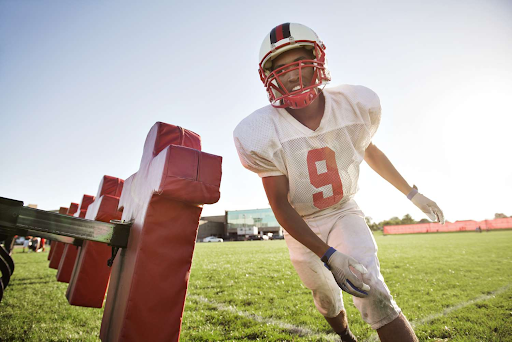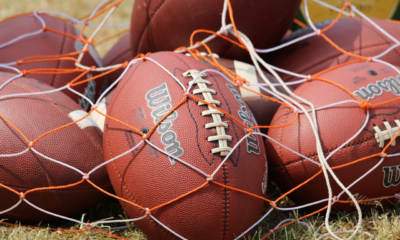
With the physical endurance and strategic insight needed to play at the professional level in American Pro Football, pros at the top of their physical game are an exceptional lot. Training like a pro athlete doesn’t merely ramp up your fitness — but also instills discipline and resilience vital in today’s fast-paced world.
The Physiology of Pro Football Athletes
In American football, knowing about fast-twitch and slow-twitch muscles is key. Fast-twitch muscles excel in quick bursts like sprints, while slow-twitch muscles are vital for endurance. This knowledge helps tailor training for both speed and stamina, crucial for pro footballers.
Energy Systems in Football
Football requires a mix of energy systems: the phosphagen system for short bursts, the glycolytic system for moderate efforts, and the oxidative system for long-lasting energy. Mastering these through training can greatly enhance performance, differentiating good from great athletes.
Nutrition for Peak Performance
Stay balanced. Protein, carbs, and fat play a major role in your muscles’ ability to repair and rebuild. Protein helps repair and rebuild muscles, carbs fuel workouts, and fats may help support overall health, as well as support the absorption of fat-soluble vitamins. Be conscious of where you are in your training phases and include carbohydrates as needed to support peak performance. As a result, some may look for the easy ways out while training, including turning to the steroids online store for a requiem for muscles. Keep your focus on safe training, with the reward of sustainable results beating anything the quick and easy route can offer.
Hydration and Electrolyte Balance
Stay hydrated and balance your electrolytes. Hydration is key in preventing cramps and supporting nerve and muscle function. Hydration and balanced electrolyte supplements are a better idea than shortcuts.
Strength Training Techniques
Compound vs. Isolation Exercises. In designing a strength program for a football player, we always begin with compound exercises, which involve multiple muscle groups (such as squats, bench presses, etc.), as they’re the most efficient and effective way to build overall strength. From there, we’ll add mid-tier and assistance exercises and then finally isolate exercises, that involve only one muscle group (biceps curls, leg extensions, etc.) — these have their place in a program, particularly about addressing weaknesses and imbalances. A balanced and properly designed program should always make room for both.
Periodization and Training Cycles. Periodization is characterized by breaking up the training calendar year into phases or cycles, each with a specific concentration. These phases might include building essential strength, working on improving the power or peaking sharply for competition. It means to avoid plateaus and stave off over-training, coaching intensity and volume are systematically varied by design, to keep workouts fresh and effective enough to sustain steady progress and achieve peak performance when it counts.
Speed and Agility Training
Optimizing sprint mechanics and form is a primary objective when seeking to enhance speed and effectiveness on the football field. In particular, focusing on appropriate posture and foot strike – and ensuring that each individual’s arm swing is coordinated correctly – can massively improve the actual speed of a sprint.
Plyometric Exercises and Agility Drills
There are many drills focused on refining each of these aspects, and each of them works to make athletes faster and more agile. Ladder runs and cone drills, for example, allow athletes to increase their quickness, and allow an athlete the opportunity to become more adroit at darting through cross-sections on the field. Exercises like jump squats and box jumps, however, assist with building that near-instantaneous power that allows a powerful football player to beat an opponent off the line or move them out of the way.
Endurance Conditioning
Endurance conditioning is essential to establishing a high level of performance throughout the entire game. Improved endurance allows players to play harder for longer, and take less time to recover. and remain effective throughout the game. A well-developed cardiovascular system delivers energy more efficiently throughout the body which means that players will have more energy to endure throughout the game. Players also can improve their overall athletic longevity with exercises that improve the overall capability of the heart and lung system during gameplay. And of course, it is pretty easy to figure out that an improved run-pass-all-the-time gameplay makes for much more efficient overall endurance within the player. One of the best ways to improve overall endurance is to exercise for longer periods regularly.
HIIT vs. LISS Training
- High-Intensity Interval Training (HIIT):
- Involves activity that has short bursts of very intense work followed by rest or low-intensity periods.
- Great for improving metabolic rate, fat loss, and cardiovascular health.
- Has a very high overall workload and volume in a very short amount of time, and is perfect for athletes with limited time looking to maximize training efficiency.
- Low-Intensity Steady State (LISS) Training:
- Consists of prolonged, consistent low-intensity exercise, such as jogging or cycling.
- Great for building endurance and fat utilization as a fuel source.
- Perfect for off/active recovery days and building a cardiovascular base without beating the body up.
Combining the best of HIIT and LISS is a well-rounded approach to conditioning that ensures football players are prepared for the specific demands of the sport and can maintain peak performance to the end of the game.
Recovery and Regeneration Methods
Sleep. Why sleep is the foundation for an NFL player’s recovery: Sleep is vital for muscle repair, cognitive function, and hormonal balance. Adequate sleep (7-9 hours/night) can significantly enhance performance, decrease injury risk, and improve decision-making.
Nutrition for Recovery and Active Recovery Techniques. Post-exercise nutrition is crucial in refueling energy stores and repairing damaged tissue. Consuming a mix of protein and carbohydrates shortly post practice or a workout allows an athlete to jumpstart the recovery process. Active recovery techniques (examples include light jogging, swimming, and yoga) are essential not just to help a player’s muscles recuperate and maintain flexibility, but also to keep soreness at bay so that he can more effectively – and efficiently – resume his training and competition.
Implementing a Pro Training Regimen
Setting Realistic Goals. Real, measurable, achievable, and time-bound goals are crucial for athletes who want to train like American pro football players. Challenging enough to push athletes to their limits, while remaining within grasp, goals will push athletes to succeed while providing clear direction for their training efforts.
Creating a Customized Training Plan and Tracking Progress. An athlete’s specific strengths and weaknesses need to be addressed with a customized training plan that meets their unique goals. By tracking progress regularly, athletes can make adjustments to their training to ensure they’re always progressing and not hitting a plateau. Coaches and effective performance metrics help to make these adjustments.
Real-Life Examples of Successful Athletes
An in-depth look at the training routines of NFL standouts demonstrates a shared commitment to intense strength, speed, and agility training, coupled with strict training, nutrition, and recovery methods. Their plans underscore a truth perhaps universal to high-performance training in any sport — that the best way to train is not as a football player, but as an athlete. The best plans intermingle various modes of human improvement, from physical to nutritional to mental, to make this the greatest version of themselves they can forge.
Elite performers have stories of struggle, adaptability, and effort over sheer mental resolve. Never forget the power of the mind in reaching goals. Once physical elements are in place, dreams will become much more reachable when mental determination is fortified.
Steps to Elevate Your Fitness to Pro Athlete Levels
To train like an American Pro Footballer takes more than killer work in the gym. It takes a strategic overall approach that uses an understanding of physiology to enable you to select the right sort of exercises, and nutrition strategies that will aid your performance, strength, speed, and agility training that is based on the real demands of the game, a way to build endurance that is reasonable and uses workouts that you love, adapting the principles that elite athletes use to support muscle recovery, and adopting the mindset and goal-tracking techniques the pros use to start with an unclear goal and push themselves through to the end by always improving, never quitting.
Continue the CFL Football discussions on our offical CFL Discord Channel


CFL News
CFL Power Rankings Week 16

CFL News
CFL Power Rankings Week 17
Big Announcement: CFL Unveils Free Live Streaming Platforms
Get Alerts & Stay Connected
CFL iPhone AppCFL Android App



















